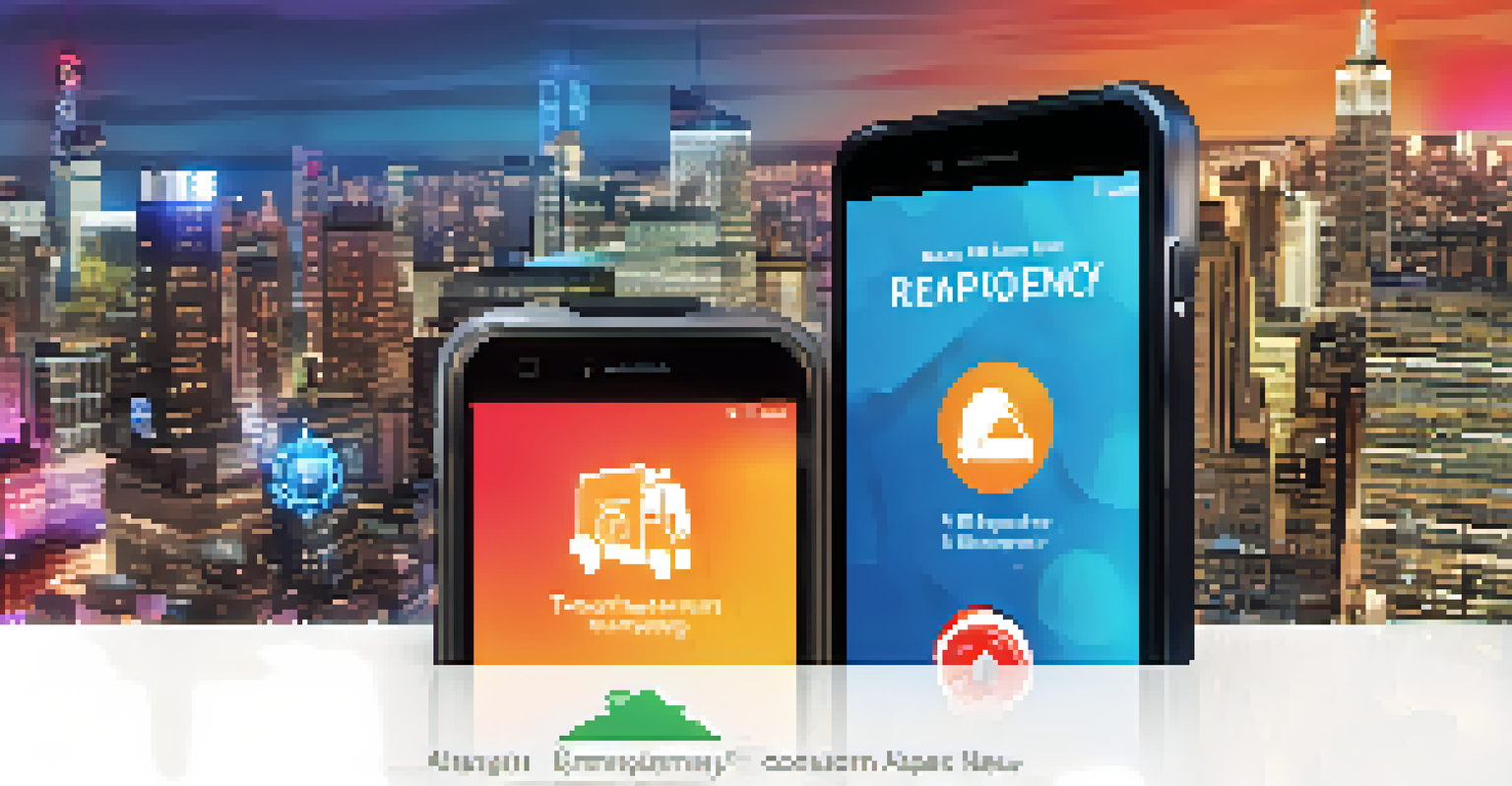The Role of Technology in Enhancing NYC Public Safety

Smart Surveillance Systems: Keeping an Eye on Safety
In New York City, smart surveillance systems have transformed the landscape of public safety. These high-tech cameras, equipped with advanced facial recognition and analytics, help law enforcement monitor crowded areas, identify suspicious behavior, and respond swiftly to incidents. By employing these systems, the NYPD can gather real-time data, allowing them to make informed decisions and allocate resources where they're most needed.
Technology is best when it brings people together.
Moreover, the use of these technologies is not just about crime prevention; it also enhances community trust. When residents see that their safety is a priority, they feel more secure and are likely to engage positively with law enforcement. This collaboration between the community and police fosters a safer environment for everyone.
However, the implementation of such systems raises questions about privacy and civil liberties. It's essential for the city to find a balance that allows for effective policing while respecting individual rights. Ongoing dialogues about these concerns ensure that technology serves the public good without overstepping boundaries.
Emergency Response Apps: Connecting Citizens and Services
Emergency response apps are revolutionizing how New Yorkers interact with public safety services. These apps empower citizens to report emergencies, suspicious activities, or even non-urgent issues directly to the relevant authorities with just a few taps on their smartphones. This not only speeds up response times but also encourages community involvement in maintaining safety.

For instance, the NYC Citizen app allows users to receive real-time updates about local incidents and emergencies, fostering a sense of vigilance and preparedness. By keeping residents informed, the app not only enhances safety but also builds a community spirit where individuals look out for one another.
Tech Enhances Public Safety
Smart surveillance systems, emergency response apps, and predictive policing are transforming how New Yorkers engage with and experience safety.
Additionally, these apps can provide critical information during larger emergencies, such as natural disasters. By keeping lines of communication open and providing timely alerts, residents can better navigate challenges, ultimately leading to a more resilient city.
Predictive Policing: Anticipating Crime Before It Happens
Predictive policing is a fascinating application of technology that aims to foresee potential criminal activity before it occurs. By analyzing historical crime data, social media trends, and environmental factors, law enforcement can identify hotspots where crime is likely to happen. This proactive approach allows police to deploy resources more efficiently and effectively.
The future belongs to those who prepare for it today.
For example, if data indicates that certain neighborhoods experience a spike in incidents during specific times, officers can increase their presence in those areas. This strategy not only deters crime but also builds trust between the police and the community, as residents feel safer knowing that their concerns are being addressed.
Nevertheless, predictive policing is not without its challenges. Critics argue it can lead to biased policing practices if not implemented judiciously. It's crucial for NYC to continually evaluate these systems to ensure they promote fairness and justice while enhancing public safety.
Drones: A New Perspective on Urban Safety
The use of drones in public safety is gaining traction in New York City, offering a unique aerial perspective that can aid in various situations. Drones can be deployed during large events to monitor crowds, assess emergency situations, and provide real-time imagery to first responders. This bird's-eye view can be invaluable during crises, allowing for quicker and more informed decision-making.
Additionally, drones can assist in search and rescue operations, particularly in hard-to-reach areas. Their ability to cover vast distances quickly helps locate missing persons or assess damage after natural disasters, demonstrating their versatility in enhancing public safety.
Community Trust is Vital
Building trust between law enforcement and residents through open communication and community engagement platforms fosters a safer environment.
However, the integration of drones into city operations also raises concerns regarding privacy and airspace regulations. As NYC moves forward with this technology, it will be essential to establish guidelines that ensure public trust while maximizing the benefits of drone usage.
Social Media Monitoring: Engaging the Community
In today’s digital age, social media has become a powerful tool for public safety initiatives in New York City. Law enforcement agencies actively monitor platforms like Twitter and Facebook to gather information on potential threats and community concerns. This proactive approach allows them to engage with residents, respond to issues in real time, and foster a sense of collaboration.
For example, during significant events or emergencies, social media serves as a vital communication channel. Authorities can disseminate information quickly, ensuring that the public remains informed about safety protocols or urgent situations. This transparency builds trust and encourages a two-way dialogue between the community and law enforcement.
However, the challenge lies in discerning credible information from misinformation. As agencies navigate this landscape, they must develop strategies to verify facts and communicate clearly, ensuring that social media enhances, rather than undermines, public safety.
Data Analytics: Transforming Public Safety Strategies
Data analytics plays a pivotal role in shaping public safety strategies across New York City. By collecting and analyzing vast amounts of data—from crime rates to community demographics—police departments can identify trends and patterns that inform their approach to safety. This data-driven decision-making helps create more effective policing strategies tailored to the needs of specific neighborhoods.
For instance, if analytics reveal a rise in particular offenses in certain areas, the NYPD can implement targeted initiatives to address these issues. This not only helps in crime prevention but also demonstrates a commitment to responsive policing, where officers are seen as problem-solvers rather than enforcers.
Data Drives Effective Strategies
Data analytics empowers police to tailor their approaches to public safety, allowing for more targeted and responsive initiatives.
Moreover, data analytics fosters collaboration among various city agencies, allowing for a unified approach to public safety. By sharing information and resources, the city can tackle complex issues like homelessness, mental health crises, and drug-related offenses more effectively.
Community Engagement Platforms: Building Trust
Community engagement platforms are essential in enhancing public safety by fostering trust between law enforcement and residents. These platforms, often accessible via mobile apps or websites, allow citizens to voice their concerns, provide feedback, and participate in local safety initiatives. By encouraging open communication, they create a sense of ownership within the community.
For example, neighborhood watch programs facilitated through these platforms empower residents to take an active role in their safety. When individuals feel they have a stake in their community's well-being, they are more likely to collaborate with police and report suspicious activities.

Additionally, regular community meetings conducted through virtual platforms can enhance transparency and accountability. This inclusive approach not only strengthens relationships but also ensures that public safety efforts align with the community's needs and values.